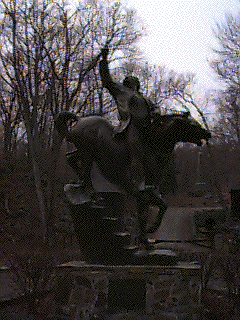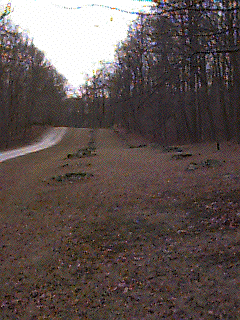

During the terrible winter of 1778-79, many Connecticut troops sheltered in the woods and fields near Redding, Connecticut, thereafter called, "Putnam's Valley Forge." Connecticut anad New Hampshire men remained firm in the mud and stone cabins in spite of misery, hunger, fierce cold, and despair because of the stern example of their commander. Since then, the place has been called "Putnam's Camp Ground."
When Washington's Northern Army went into winter quarters at the end of November 1778, it was disposed in an arc from New Jersey to Connecticut, so as to ring the British garrison in New York. Three of the army's brigades had their winter encampment at Redding, when they could move east to defend the Hudson Heights or west to defend the Connecticut coast from British raiders. Their commander was Major General Israel ("Old Put") Putnam.
That winter was relatively mild, but the harvest had been poor, and supplies were scarce. The men, many of whom had been through the hell of Valley Forge the previous year, began to mutter about a similar privation winter in Connecticut. Then in December the state experienced one of the worst winter storms in New England history. Two days after it ended, the men of one brigade mutinied and prepared to march on the State Assembly in Hartford to demand overdue supplies and wages. Putnam was able to break up the affair only with the greatest of difficulty. Thus the winter encampment at Redding that came to be known as "Connecticut's Valley Forge."
The original encampment in now the site of Putnam Memorial State Park at the junction of Routes 58 and 107 in West Redding. The twelve-man huts are now just piles of stone where their chimneys stood, and the old magazine is only a stone-lined pit; but the officers' barracks has been rebuilt, and there is a museum on site containing exhibits dealing with the Redding encampment. There's also a great statue by the front gate showing Old Put riding his horse down a flight of stairs to escape capture during a British raid in February of 1779.
Redding - On both sides of R. 58, just below the Bethel town line, is the Putman Memorial Camp Ground, the "Valley Forge" of Connecticut, where Gen. Israel Putnam and a force of Connecticut and New Hampshire troops were encamped during the hard winter of 1778-9. The property is now a State Reservation of 203 acres. Passing through the gateway, in the form of two blockhouses, extended in a palisade, we face the Monument, erected by the State in 1889. The rows of stone nearby, running toward the north, mark the chimneys of the former barracks. Further, on our left, is the stone Colonial Museum, with its Revolutionary relics. On the grounds, which have been left as far as possible in their native state, are attractive drives and paths, with a lake on the east side of the highway. To the west is Phillips Cave, associated with an old soldier who returned here after the war and was killed for thieving.
Passing several old houses in a thickly wooded district, State 58 reaches Israel Putnam Memorial Camp Grounds, Connecticut's 'Valley Forge', where General Israel Putnam's troops, the 'right wing' of the Continental Army, endured the rigors of the bitter winter of 1778-79, when they camped here in order to be in a strategic position to march to the defense of West Point or the towns on Long Island Sound.
Guarding either side of the entrance are reproductions of Revolutionary block-houses. Within the park are several attractive drives leading past the granite obelisk commemorating General Putnam's impassioned speed to the poorly clothed and scantily fed soldiers who threatened to desert and had already formed in line to march to Hartford to demand redress.
Right one 'Company Street', are tumble-down stone piles, the remains of chimneys of the soldiers' huts, lying exactly as they fell when the troops burned the cabins after they evacuated them in May, 1779.

A short distance farther on to the Colonial Museum (open from Decoration Day to the end of Sept., 1-5), which includes in its collection many Revolutionary relics found on the grounds.
The main driveway leads past Philip's Cave, about which many legends have been told, to a reproduction of one of the army cabins, and beyond to a little circular driveway, the site of the camp fire, where Joel Barlow, one of the celebrated 'Hartford Wits,' entertained the soldiers. Down the hill is the old camp oven.
General Israel Putnam's last hurrah came at Redding, amid the suffering and dying troops under his command, during the terrible winter of 1778-1779, in the encampment forever after known at "Putnam's Valley Forge." Here a contingent of Connecticut and New Hampshire volunteers somehow survived the hunger, cold and despair of that bitter bivouac only because their commander, suffering fully as much as his men, served as an inspirational model of courage and attention to duty.
What is the inward meaning and explanation, for example, of that pathetic legend they tell in Redding, at the Putnam Memorial Camp, about "Phillips' Cave"? The bare facts are, apparently, that some time after the winter of 1778-79 when several hundred Revolutionary soldiers encamped there under the leadership of Israel Putnam - one can still see the scattered stones of their fireplaces stretching in long straight lines down the hill - one of these soldiers, Phillips by name, wandered back to the place and lived alone there for a time in a cave among the tumbled rocks. He lived at first, as his old comrades had done, upon the game he could kill, then upon alms, and at last upon what pigs and poultry he could steal. Tiring of his depredations, the farmers of the region lay in wait for him one evening and shot him dead as he came out of his cave.
There ends the legend, telling us nothing about the man's motive in returning to a desolate region where he and many companions had suffered a prolonged misery like that of Washington's little army at Valley Forge. One would think that all those who endured that freezing, starvation, and nakedness would have wished to forget it entirely. Why should he wish to remember?
For lack of any better explanation I interpret this tale in terms of human loneliness. I think of the man Phillips as coming from one of those northwestern towns of the State which emptied themselves soon after the Revolutionary War into Vermont, New Hampshire, western Massachusetts, New York, and Ohio. Some duty to ageing parent may have prevented him from joining any of these migrations, and while he himself grew older the forest crowded every year more closely roudn the uplandish farm where he lived and worked alone. Would it not have been a natural thing for him to go back, as soon as he was free, to the one place in which he had once been surrounded by companions? The rude barracks they had built were falling to pieces, no doubt, when he returned, and their flimsy roofs let in the rain and snow, but it was something to be so near the now ruined fireplaces where a host of young men, a great tatterdemalion crowd of comrades, had once laughed and played and starved together.

Fairfield County - Philips Cave - Bethel Quad.
The cave is 4 mi. SE of Danbury Ct. off Rt. 58 and just north of Rt. 107. Look for a large obvious talus pile with a wooden handrail nearby. There are three entrances.
Equal to, but not as well known, were the troubles of General Putnam and his terrible winter spent, like Valley Forge, with his brave soldiers in Putnam Park, Redding, Ct. This historic area, now a Connecticut state park, can return you to the old days .... the site is kept alive with the memories of a great past.....Here in the park is interesting Phillips Cave. A jumble rock group that certainly has an interesting story and historic past. Philips was a man who lived there and before he was caught by local farmers and killed for being a "chicken thief" he really lived it up stealing food and selling it to cold starving soldiers that made Putnam Park famous as Connecticut's Valley Forge. The gateway and entrance to the park has a pair of block houses reconstructed as a reminder of the past days. Along the drive are heaps of stones that once were foundations and fireplaces of the barracks and cabins of General Putnam's main winter quarters. It is a great place to visit and know and an interesting small cave site.
In Redding, Connecticut, is Putnam's Valley Forge. Here, during that hard winter of 1778-79, when rations were short and morale was low, Israel Putnam rendered one of the greatest services of all to the Continental cause, fighting the grim, cruel, ruthless enemies of hunger, cold, and despair. Connecticut and New Hampshire troops starved and froze there with this intrepid commander.
The property, 203 wooded acres, is now a State Reservation and shrine. In a sheltered valley, watered by a lively stream, are two blockhouse gateways flanked by a palisade. Within, facing the entrance, is a monument erected by the state in 1889. On the line of the company streets, tumbled exactly where they fell in odd-shaped heaps, are the stones of the old mud-and-stone cabin chimneys, the real monuments that ragged, miserable men erected with their chilled hands. In the museum are Revolutionary War relics and, somewhere in the woods, is a cave where an old soldier lived until he was killed for stealing. Sometimes, when the valley is draped with mist, an odor of frying bacon assails the nostrils of the passerby, as if "Old Put's Boys" were cooking their meager breakfasts. The odor is from yesterday's picnic party, because people often bring their lunches to Putnam's Camp Ground, perhaps because a meal tastes better if eaten where men have starved. But nature has reclaimed the area and new timber has grown where Putnam's men cut their firewood to frizzle their bacon and boil their beans. Now even the swans on the lake nearby are well-fed.